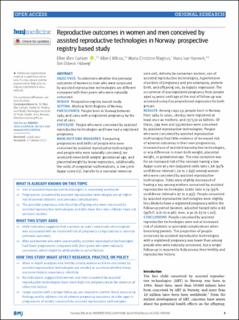| dc.description.abstract | Objectives To determine whether the perinatal outcomes of women or men who were conceived by assisted reproductive technologies are different compared with their peers who were naturally conceived. Design Prospective registry based study. Setting Medical Birth Registry of Norway. Participants People born in Norway between 1984 and 2002 with a registered pregnancy by the end of 2021. Exposure People who were conceived by assisted reproductive technologies and have had a registered pregnancy. Main outcome measures Comparing pregnancies and births of people who were conceived by assisted reproductive technologies and people who were naturally conceived, we assessed mean birth weight, gestational age, and placental weight by linear regression, additionally, the odds of congenital malformations, a low 5 min Apgar score (<7), transfer to a neonatal intensive care unit, delivery by caesarean section, use of assisted reproductive technologies, hypertensive disorders of pregnancy and pre-eclampsia, preterm birth, and offspring sex, by logistic regression. The occurrence of any registered pregnancy from people aged 14 years until age at the end of follow-up was assessed using Cox proportional regression for both groups. Results Among 1 092 151 people born in Norway from 1984 to 2002, 180 652 were registered at least once as mothers, and 137 530 as fathers. Of these, 399 men and 553 women were conceived by assisted reproductive technologies. People who were conceived by assisted reproductive technologies had little evidence of increased risk of adverse outcomes in their own pregnancies, increased use of assisted reproductive technologies, or any difference in mean birth weight, placental weight, or gestational age. The only exception was for an increased risk of the neonate having a low Apgar score at 5 min (adjusted odds ratio 1.86 (95% confidence interval 1.20 to 2.89)) among women who were conceived by assisted reproductive technologies. Odds were slightly decreased of having a boy among mothers conceived by assisted reproductive technologies (odds ratio 0.79 (95% confidence interval 0.67 to 0.93)). People conceived by assisted reproductive technologies were slightly less likely to have a registered pregnancy within the follow-up period (women, adjusted hazard ratio 0.88 (95% CI 0.81 to 0.96); men, 0.91 (0.83 to 1.01)). Conclusions People conceived by assisted reproductive technologies were not at increased risk of obstetric or perinatal complications when becoming parents. The proportion of people conceived by assisted reproductive technologies with a registered pregnancy was lower than among people who were naturally conceived, but a longer follow-up is required to fully assess their fertility and reproductive history. | |
